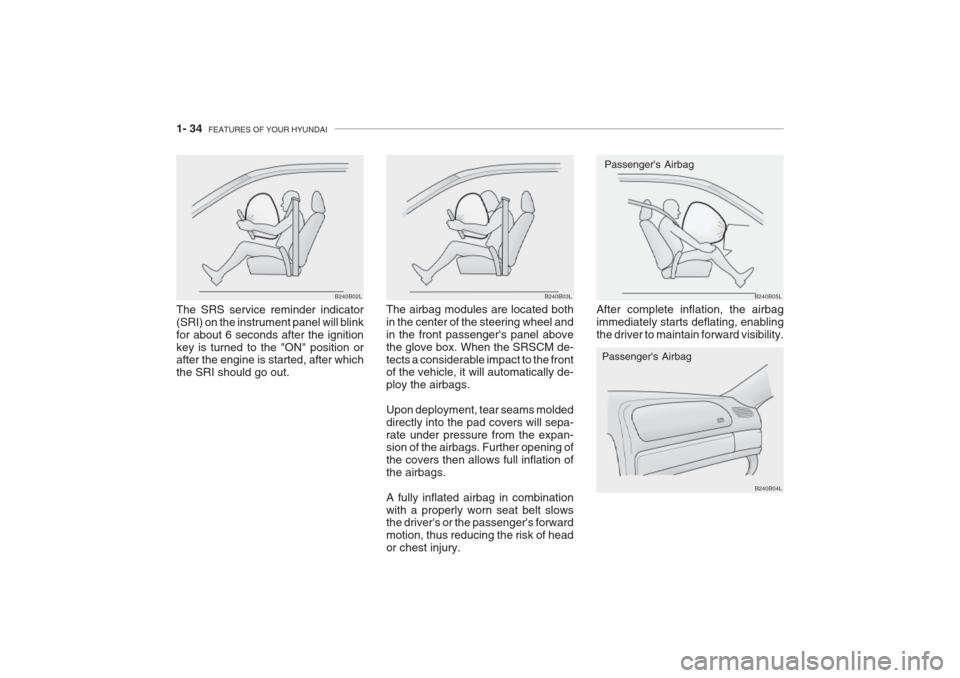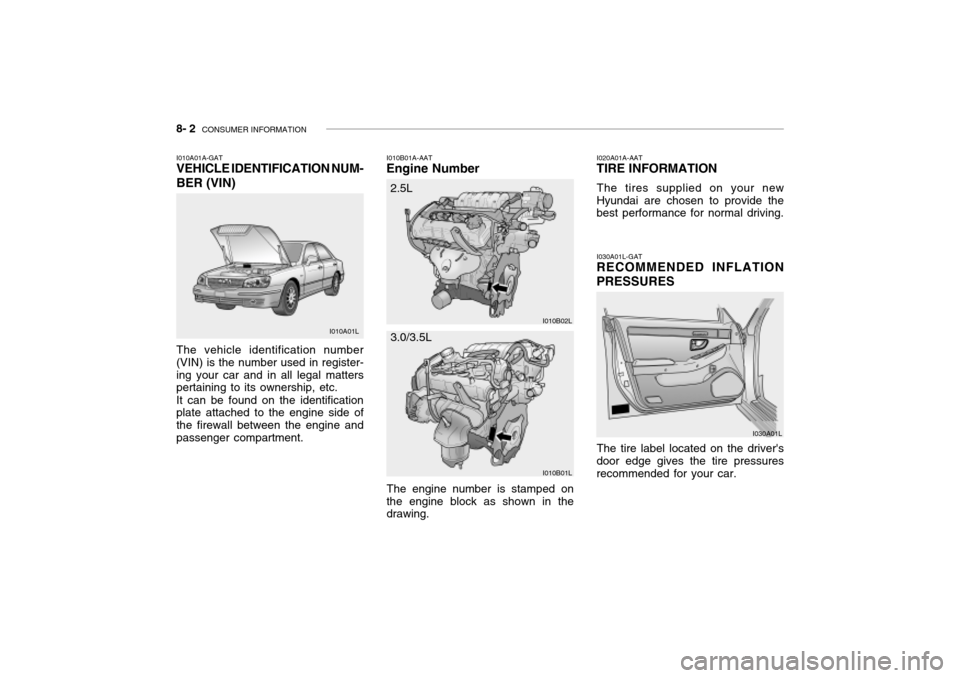2002 Hyundai Grandeur inflation pressure
[x] Cancel search: inflation pressurePage 47 of 230

1- 34 FEATURES OF YOUR HYUNDAI
Passenger's Airbag
B240B05L
B240B04L
Passenger's Airbag
After complete inflation, the airbag immediately starts deflating, enablingthe driver to maintain forward visibility.
B240B03L
The airbag modules are located bothin the center of the steering wheel andin the front passenger's panel abovethe glove box. When the SRSCM de-tects a considerable impact to the front of the vehicle, it will automatically de- ploy the airbags. Upon deployment, tear seams molded directly into the pad covers will sepa-rate under pressure from the expan- sion of the airbags. Further opening of the covers then allows full inflation ofthe airbags. A fully inflated airbag in combination with a properly worn seat belt slows the driver's or the passenger's forward motion, thus reducing the risk of heador chest injury.
B240B02L
The SRS service reminder indicator (SRI) on the instrument panel will blinkfor about 6 seconds after the ignitionkey is turned to the "ON" position or after the engine is started, after which the SRI should go out.
Page 146 of 230

DRIVING YOUR HYUNDAI 2- 17
C160I01A-AAT Don't Let Your Parking Brake Freeze Under some conditions your parking brake can freeze in the engaged posi-tion. This is most likely to happenwhen there is an accumulation of snow or ice around or near the rear brakes or if the brakes are wet. If there is a riskthe parking brake may freeze, apply itonly temporarily while you put the gearselector lever in "P" (automatic) or infirst or reverse gear (manual transaxle) and block the rear wheels so the car cannot roll. Then release the parkingbrake.
C160H01A-AAT Use Approved Anti-Freeze in Window Washer System To keep the water in the window washer system from freezing, add an approvedanti-freeze solution in accordance withinstructions on the container. Windowwasher anti-freeze is available fromHyundai dealers and most auto parts outlets. Do not use engine coolant or other types of anti-freeze as thesemay damage the finish.
C160K01A-AAT Carry Emergency Equipment Depending on the severity of the weather where you drive your car, youshould carry appropriate emergency equipment. Some of the items you may want to carry include tire chains,tow straps or chains, flashlight, emer-gency flares, sand, a shovel, jumpercables, a window scraper, gloves,ground cloth, coveralls, a blanket, etc.
C160J01A-AAT Don't Let Ice and Snow Accumu- late Underneath Under some conditions, snow and ice can build up under the fenders andinterfere with the steering. When driv-ing in severe winter conditions wherethis may happen, you should periodi- cally check underneath the car to be sure the movement of the front wheelsand the steering components is notobstructed.
C170A01A-AAT HIGH SPEED MOTORING Pre-Trip Inspections 1. Tires: Adjust the tire inflation pressures tospecification. Low tire inflation pres-sures will result in overheating andpossible failure of the tires. Avoid using worn or damaged tires which may result in reduced traction ortire failure. NOTE: Never exceed the maximum tire in- flation pressure shown on the tires. 2. Fuel, engine coolant and engine oil: High speed travel consumes 1.5 timesmore fuel than urban motoring. Do notforget to check both engine coolantand engine oil. 3. Drive belt: A loose or damaged drive belt mayresult in overheating of the engine.
Page 155 of 230

WHAT TO DO IN AN EMERGENCY 3- 5
Spare Tire Pressure D040B01A-AAT Handling the Spare Tire Remove the installation bolt to remove the spare tire. To replace the spare tirein its storage compartment, tighten thebolt firmly with your fingers until there is no more play in the spare tire.D050A01A-AAT IF YOU HAVE A FLAT TIRE If a tire goes flat while you are driving:
1. Take your foot off the accelerator
pedal and let the car slow down while driving straight ahead. Do not apply the brakes immediately or at- tempt to pull off the road as this maycause a loss of control. When thecar has slowed to such a speed thatit is safe to do so, brake carefullyand pull off the road. Drive off the road as far as possible and park on firm, level ground. If you are on adivided highway, do not park in themedian area between the two trafficlanes.
2. When the car is stopped, turn on your emergency hazard flashers,set the parking brake and put thetransaxle in "P" (automatic) or re-verse (manual transaxle).
3. Have all passengers get out of the
car. Be sure they all get out on the side of the car that is away from traffic.
4. Change the tire according to the
instructions provided as following.
HXGS408
D040A01L-GAT SPARE TIRE The following instructions for the FULL SIZE spare tire should be observed:Check inflation pressure as soon aspractical after installing the spare tire,and adjust to the specified pressure. The tire pressure should be periodi- cally checked and maintained at thespecified pressure while the tire isstored.
6.0x15 6.0x16 TIRE SIZE
RIM
SIZE PRESSURE, kPa (PSI)
205/65R15 94V205/60R16 96V REAR
210(30) 210(30) FRONT240(35) 240(35)
NORMAL LOAD MAXIMUM LOAD
REAR
240(35)240(35)
FRONT220(32) 230(33)
Page 216 of 230

8. CONSUMER INFORMATION
Vehicle Identification Number (VIN) .............................................. 8-2
Engine Number .............................................................................. 8-2
Recommended Inflation Pressures ................................................ 8-2
Snow Tires ...................................................................................... 8-3
Tire Chains ..................................................................................... 8-4
Tire Rotation ................................................................................... 8-4
Tire Balancing ................................................................................. 8-4
Tire Traction ................................................................................... 8-5
When to Replace Tires .................................................................. 8-5
Spare Tire and Tools ..................................................................... 8-5
8
Page 217 of 230

8- 2 CONSUMER INFORMATION
I010B01A-AAT
Engine Number
I010A01A-GAT VEHICLE IDENTIFICATION NUM- BER (VIN) The vehicle identification number (VIN) is the number used in register-ing your car and in all legal matters pertaining to its ownership, etc. It can be found on the identification plate attached to the engine side of the firewall between the engine andpassenger compartment.
The engine number is stamped on
the engine block as shown in the drawing. I020A01A-AAT
TIRE INFORMATION
The tires supplied on your new
Hyundai are chosen to provide thebest performance for normal driving.
I030A01L-GAT
RECOMMENDED INFLATION PRESSURES
The tire label located on the driver's
door edge gives the tire pressures recommended for your car.
I010A01L
I010B02L
I030A01L
I010B01L
2.5L 3.0/3.5L
Page 218 of 230

CONSUMER INFORMATION 8- 3
CAUTION:
Always observe the following:
o Check pressures when the tires are cold. That is, after the car has been parked for at least threehours and hasn't been driven more than 1.6 km or one mile since starting up.
o Check the pressure of your spare tire each time you check thepressure of other tires.
o Never overload your car. Be es- pecially careful about overload-ing if you equip your car with a luggage rack or car top carrier. I040A01S-GAT SNOW TIRES If you equip your car with snow tires, they should be the same size and have the same load capacity as the original tires. Snow tires should beinstalled on all four wheels; other- wise, poor handling may result. Snow tires should carry 28 kPa (4 psi) more air pressure than the pres- sure recommended for the standard tires on the tire label on the driver'sdoor edge, or up to the maximum pressure shown on the tire sidewall whichever is less.Do not drive faster than 120 km/h (75mph) when your car is equipped withsnow tires.
6.0x15 6.0x16
TIRE SIZE
RIM
SIZE PRESSURE, kPa (PSI)
205/65R15 94V205/60R16 96V REAR
210(30) 210(30) FRONT
240(35) 240(35)
NORMAL LOAD MAXIMUM LOAD
REAR
240(35)240(35)
FRONT
220(32)230(33)
These pressures were chosen to pro-
vide the most satisfactory combina-tion of ride comfort, tire wear and stability under normal conditions. Tire pressures should be checked at least monthly. Proper tire inflation pressures should be maintained for these reasons:
o Lower-than-recommended tire pressures cause uneven tread wear and poor handling.
o Higher-than-recommended tire pressures increase the chance ofdamage from impacts and causeuneven tread wear.
!